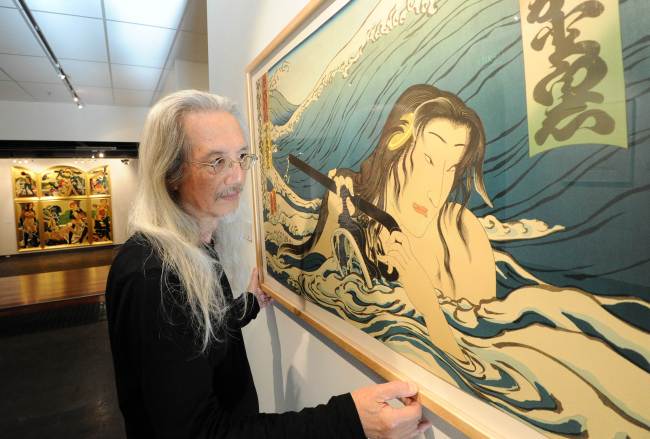SYDNEY (AFP) ― Japanese-born artist Masami Teraoka remembers the bombing of Hiroshima as the day when he saw two suns rising ― one in the east as usual, the other an orb burning eerily in the west.
“Two suns, that’s for sure. That’s my memory,” he explained from a Sydney gallery where his confrontational images of geishas ripping condom packets open with their teeth and naked women frolicking with priests are being exhibited.
“I’m not looking at the mushroom cloud at all, but from a distance it looked like the sun. The diameter was the same size as the sun,” he said of the massive atomic explosion he viewed some 45 km from Hiroshima.
 |
This photo taken on May 25 shows Japanese-born artist Masami Teraoka, age 78, as he straightens his painting entitled “Namiyo at Hanauma Bay 1985” at his exhibition in Sydney. (AFP-Yonhap News) |
Teraoka has thought a lot about the reliability of his schoolboy recollection since that day in August 1945, but he believes it is possible that his memory, even then highly attuned to the visual, is genuine.
“So I may not be totally crazy, I think this is totally right,” the chatty, long-haired artist said with a laugh.
Teraoka left Japan when he was 25, after studying at Kobe’s Kwansei Gakuin University, and while he credits his move away as crucial to his development, he now sees Asia at the forefront of the contemporary art scene.
Back then, moving to the United States allowed him to follow his passion rather than run the kimono shop owned by his father and grandfather.
He believes his move to Los Angeles in the early 1960s, where he studied at the Otis Art Institute, allowed him to develop.
“Actually if I stayed in Japan, I would have become a businessman,” the artist, now in his mid-70s, said.
“Japanese culture is very much a conformist culture and I kind of doubt I would have blossomed the way I have blossomed and matured as an artist in the States.”
More than 70 solo exhibitions later, including at the Whitney Museum of American Art, Washington’s Arthur M. Sackler Gallery at the Smithsonian Institution and San Francisco’s Asian Art Museum, Teraoka said China is now tackling art on a scale unseen elsewhere.
“I think Hong Kong, Beijing, Shanghai are leading contemporary arts scenes from now on,” he said.
His art has also reflected the changing times ― beginning with traditional Japanese ukiyo-e “floating world” drawings and prints, admittedly with a modern take such as his 1974 “Burger and Chopsticks” about creeping western influence.
Since his move to the U.S. in 1961, he has continued to marry East and West, with his paintings sometimes reminiscent of Northern European work from the late 15th century.
His latest pieces, which focus on sex abuse among the clergy, feature full-figured nude women and bishops and priests in large-scale paintings that subvert traditional religious iconography with modern symbols such as traffic lights, gyms, and IVF equipment.
“The themes that I am dealing with are pretty tough themes: religion and sexuality and ethics and human rights and also power against powerless people,” he explained.








